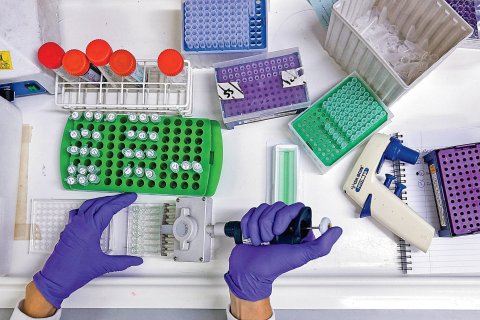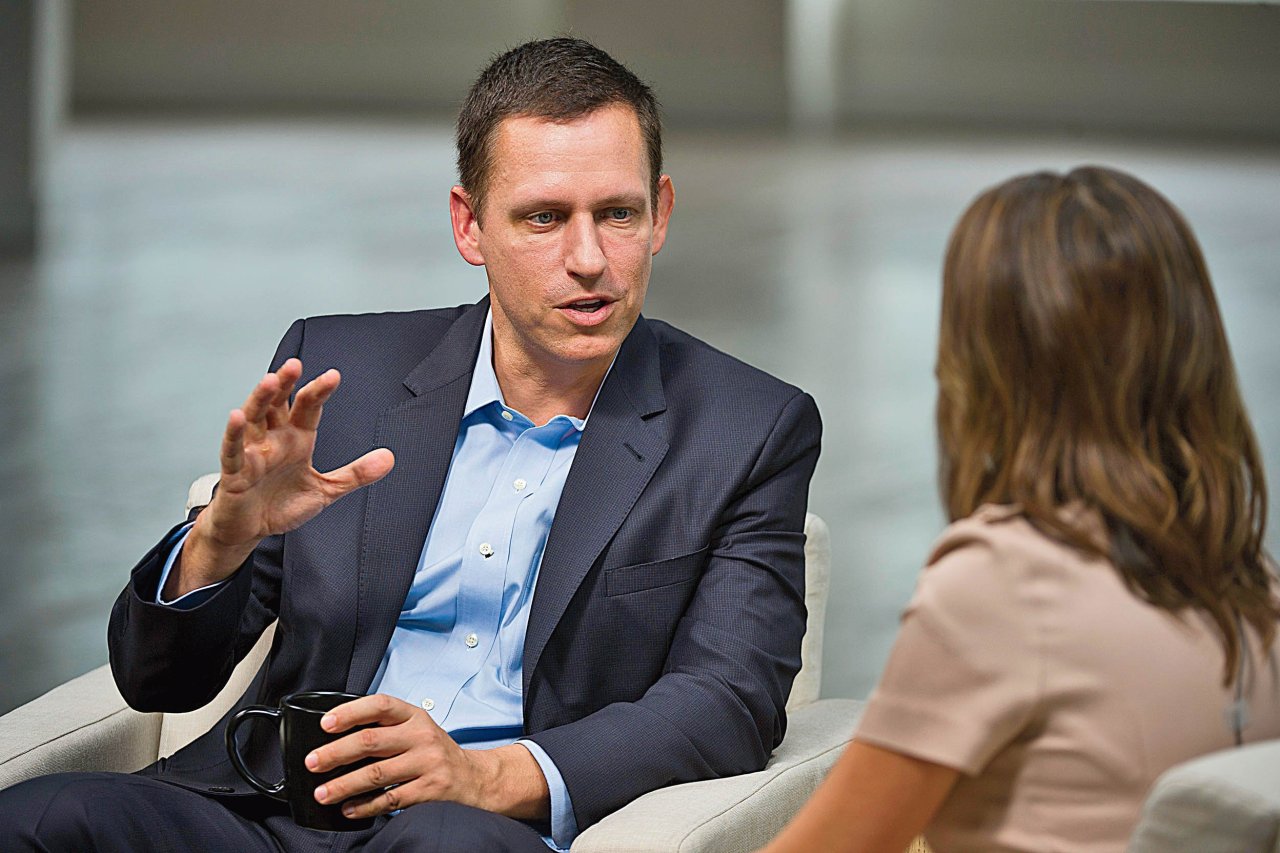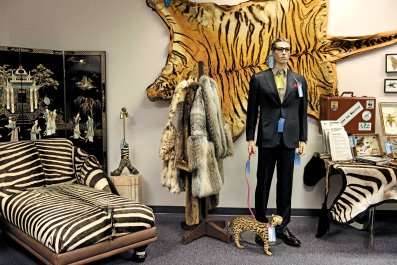Peter Thiel, the billionaire co-founder of PayPal, plans to live to be 120. Compared with some other tech billionaires, he doesn't seem particularly ambitious. Dmitry Itskov, the "godfather" of the Russian Internet, says his goal is to live to 10,000; Larry Ellison, co-founder of Oracle, finds the notion of accepting mortality "incomprehensible," and Sergey Brin, co-founder of Google, hopes to someday "cure death."
These titans of tech aren't being ridiculous, or even vainglorious; their quests are based on real, emerging science that could fundamentally change what we know about life and about death. It's hard to believe, though, since the human quest for immortality is both ancient and littered with catastrophic failures. Around 200 B.C., the first emperor of China, Qin Shi Huang, accidentally killed himself trying to live forever; he poisoned himself by eating supposedly mortality-preventing mercury pills.
Centuries later, the search for eternal life wasn't much safer: In 1492, Pope Innocent VIII died after blood transfusions from three healthy boys whose youth he believed he could absorb. A little closer to modern times, in 1868 America, Kentucky politician Leonard Jones ran for the U.S. presidency on the platform that he'd achieved immortality through prayer and fasting—and could give his secrets for cheating death to the public. Later that year, Jones died of pneumonia.

But historical precedent hasn't dissuaded some of the biggest names in Silicon Valley. Thiel, for example, has given $3.5 million to the Methuselah Foundation. Aubrey de Grey, Methuselah's co-founder, says the nonprofit's main research initiative, Strategies for Engineered Negligible Senescence (SENS), is devoted to finding drugs that cure seven types of age-related damage: "Loss of cells, excessive cell division, inadequate cell death, garbage inside the cell, garbage outside the cell, mutations in the mitochondria, and crosslinking of the extracellular matrix.… The idea is that the human body, being a machine, has a structure that determines all aspects of its function, including its chance of falling apart any time soon, so if we can restore that structure—at the molecular and cellular level—then we will restore function too, so we will have comprehensively rejuvenated the body."
But SENS, which has an annual operating budget of $5 million, is puny compared with the Brin-led Project Calico, Google's attempt to "cure death," which is planning to pump billions into a partnership with pharmaceutical giant AbbVie. Google is notoriously secretive, but it's rumored to be building a drug to mimic foxo3, a gene associated with exceptional life span.
Then there's the Glenn Foundation for Medical Research, the granddaddy of modern antiaging initiatives, started by venture capitalist Paul F. Glenn in 1965. Since 2007, the foundation has distributed annual "Glenn Awards," $60,000 grants to independent researchers doing promising work on aging. The Glenn Foundation also works to kick-start antiaging initiatives within large institutions ("It began at Harvard, and then we sought out MIT and then the Salk Institute and then the Mayo Clinic," Mark R. Collins, spokesman for the Glenn Foundation, explains), and it puts more than $1 million per year toward grants by the American Federation for Aging Research, a charitable foundation dedicated to age-related disease.
The Glenn Foundation also works closely with the Ellison Medical Foundation, a far younger institution (founded in 1997). Ellison's passion project gives out hundreds of thousands of dollars in grants each year to scholars pursuing research on, and remedies for, aging. Their decision to fund independent research—as opposed to creating grandiose, in-house programs—may be paying off. Relatively modest research projects funded by Ellison and Glenn appear to be developing into a verifiable means to stave off old age—for lab mice. The tantalizing question: Can those lab results be replicated in humans?

Aging in Reverse
In 1956, gerontologist Clive M. McCay performed a somewhat ghoulish experiment on the rural upstate New York campus of Cornell University: He sewed the flanks of live mice together in order to link their bloodstreams. In the pairings McCay stitched together, one mouse was spritely, healthy and young; the other was old and in relatively bad shape. With their bloodstreams linked, the old mouse seemed to age in reverse, getting healthier and younger as the experiment continued. The young mouse, meanwhile, aged prematurely.
At the time, relatively little was understood about the makeup of blood. McCay's experiments were fascinating but a bit of a dead end, so he shifted his focus to calorie restriction, where his experiments eventually made him famous, while his ingenuous blood work was largely left to languish.
Fast-forward 48 years to 2004. Amy Wagers, at Harvard University's Department of Stem Cell and Regenerative Biology, repeated McCay's flank-stitching experiments to see if she could reproduce his results. And it worked. So Wagers—in part funded by Glenn and Ellison—decided to try to isolate individual proteins in the mouse blood to see what was causing the ghoulish effect.
She found that a protein called GDF11, common in the blood of young mice but sparse in the systems of the older rodents, caused much of the old mice's "reverse aging." In the bloodstream, GDF11 is responsible for keeping stem cells active; when GDF11 levels drop, as they do with age, stem cells (which are responsible for tissue renewal) falter, injuries heal more slowly and aging begins to take hold. But even in very elderly bodies with very little GDF11 inside them, those stem cells never go away—they merely become dormant as GDF11 levels drop. Injecting young blood, with its high levels of GDF11, into old mice seemed to restart those dormant stem cells, causing the old mice to "age in reverse" as they produced the healthy, vital tissues associated with youth. The work is "incredibly promising," says Collins.
Meanwhile, at the M.D. Anderson Cancer Center in Houston, one of the Ellison Medical Foundation's Senior Scholars in Aging had also been experimenting with ways to keep mice from growing old. Dr. Ronald DePinho was interested in telomeres, structures that cap the tips of chromosomes like aglets do the end of shoelaces. In young bodies, an enzyme called telomerase keeps telomeres healthy and stable; in older bodies, levels of telomerase drop, telomeres shorten, and the chromosomes begin to fray. It seemed likely these fraying chromosomes were responsible for some of the physical effects of aging, and DePinho wanted to find out how.

His team genetically engineered mice whose telomerase output could be toggled and found that in the "off" state, where there was no telomerase at all, the mice aged prematurely. "We took them to the point where they were the equivalent of 90-year-old humans," he says, "with shrunken brains, impaired cognition, infertility, thin bones, hair loss, etc."
Then DePinho and his colleagues toggled the telomerase back on—and what he saw was incredible. "The organs started to restore themselves," he says. "The brain increased in size, cognition was improved, fertility was restored, hair returned to a healthy sheen, and all of the other problems that we saw in the animal were alleviated." Giving telomerase to a telomerase-deprived animal didn't just halt the aging process—like GDF11, it seemed to make the animals younger.
Might either or both of these discoveries be used to create a Ponce de Leon–style fountain of youth? "We've not done any life span studies on these animals, so we don't know whether this would have an effect on their life span. But we think that it would affect one's health span—meaning the number of years that you live without a significant illness," says Wagers. Preliminary studies look promising. Wagers says a colleague has been looking into a protein she describes as the fly version of GDF11. "When he gives more of it to flies, they live longer. And if he takes it away, their life span is shortened."
There's one (huge) caveat here. Telomerase is linked to both the prevention and progression of cancer. Aging cells that lack telomerase are more likely to become cancerous; when older cells replicate, their "fraying" chromosomes, unprotected by telomeres, often give birth to cancer-causing mutations. And once cells become cancerous, their telomerase levels rise, letting the mutant cells spread and multiply uncontrollably. Doctors treating cancer often work to deprive those spreading cells of telomerase—and many are worried that flooding the body with telomerase might help cancer along. In other words, this path toward making us live longer could kill us.
DePinho and others think telomerase therapy will likely reduce the incidence of cancer—by making chromosomes less likely to fray. And though scientists like University of California, Berkeley's Irina M. Conboy have raised concerns that GDF11, by promoting cell regrowth, might also increase cancer incidents, Wagers's cautious optimism mirrors DePinho's: She says there is no evidence GDF11 causes higher incidence of deadly diseases. Still, she says, more experiments must be done. Neither she nor DePinho think their substances of choice will reach human clinical trials for several years yet.

But with discoveries like Wagers's and DePinho's prompting an eruption of scientific excitement, the idea that we could live longer—not a few years more but maybe a century or even several hundred years longer—suddenly becomes one of the more stirring and controversial topics of the coming century. "What this means for longevity must be defined carefully, of course, because with such dramatic developments there will be a very big difference between how long people have lived so far and how long people expect to live," says de Grey. If we start living for an average of 400 years instead of an average of 80, we may have to rewrite a lot of the stories we tell ourselves about how life—and death—work.
According to Wagers, if aging can be reversed, instead of the slow, steady decline into senescence we are used to, we might just live and live and keep on living, as healthy and apparently young-seeming humans, right until some organ or other fails catastrophically. This in stark contrast to the dystopian future imagined by, for example, Gregg Easterbrook last year in the article "What Happens When We All Live to 100?" in The Atlantic. Easterbrook and others posit a future in which life spans keep extending but "health spans" don't, and the sickly elderly live for decades and suck all of the money out of the economy. In Wagers's version, on the other hand, everybody stays healthy right until they die—so maybe there doesn't need to be a retirement age, and the economy grows and grows. Though perhaps that's a recipe for another kind of dystopia: one where we work and work and work and never stop working for 384 years, until the day we die.

Print Your New Liver
But maybe, in the future, we won't need to worry about organ failure. For all those times when there isn't an organ to spare, there'll soon be cloned copies, either grown in the lab or 3-D printed: We've already 3-D printed livers and kidneys, turned skin cells into stem cells and stem cells into organs, and we're redefining the definition of fatality, thanks to a procedure called cold saline resuscitation. Replacing a dying body's blood with a rush of cold saline can drop the body's temperature and put a dying patient into a state of suspended animation. And once a patient is in that state, doctors can fix a whole lot of things that might otherwise be fatal: gunshot and knife wounds, hemorrhages and organ failure—especially if there's a handy supply of spare, cloned organs available in the emergency room.
To our current tastes, there's something a little ghastly about this paradigm: living forever, or at least a long time, in an eternal, static youth, with trips to the emergency room more frequent as we get older, to periodically replace failing organs. According to a 2012 Pfizer study, when it comes to aging, our greatest fears are of "being dependent" or "living in pain." That might be replaced in our cultural imagination by fear of eternal youth leading to sudden, stunning death—what if your heart, 200 years old, suddenly gives out when you're nowhere near a hospital? The body horror of the future may be very different from today's, but it's body horror all the same.
Perhaps the fix is to replace bodies—these unreliable vessels, plagued with problems!—altogether. That's the goal of the most ambitious billionaire-backed immortality investment of them all, Itskov's 2045 Initiative. Founded in early 2011, the initiative has already collected an impressive set of experts in specialties ranging from robotics and neural interfaces to artificial organ creation. Their goal: replace our current meaty cases with robotic or holographic avatars by (you guessed it) 2045.
In some ways, the 2045 Initiative's goal isn't as ridiculous as it sounds. Tele-operated robotic avatars exist, though so far they're more novelty than lifestyle choice. Itskov thinks that as tele-operated avatars become more fine-tuned, "the jobs with an increased risk to human life and health, such as that of a fireman, a police officer, a first-responder, a miner, etc., will disappear." Eventually, says Itskov, these tele-operated avatars will be "superior to the biological body in terms of its abilities," thereby ushering in an era of increased avatar popularity.

But even if such robot avatars get cheaper and experience a sudden upswing in use, consciousness is still tied to our meaty, messy brains—and thus far, no one's yet made headway in transferring it to a more durable medium.
That's not to say no one's trying. Tech giant Intel is aiming to have an "exascale" computer—a computer that can operate at the same speed as the human brain—by 2018. And in August 2013, researchers from Japan and Germany used Japan's K supercomputer to simulate 1 percent of brain activity for one second. That may not sound like much to be excited about, but with exascale machines on the horizon, it's surely a sign of what's to come. Markus Diesmann, one of the scientists involved in the K supercomputer experiment, told The Daily Telegraph in 2014, "If petascale computers like the K computer are capable of representing 1 percent of the network of a human brain today, then we know that simulating the whole brain at the level of the individual nerve cell and its synapses will be possible with exascale computers—hopefully available within the next decade."

Youth Is Wasted on the Old
But whether we achieve immortality through robots, injections or protein packs, one profound and disturbing question remains: Do we really want to live forever? And if so, why?
Itskov says he's driven by frustration. A serial hobbyist, the Russian billionaire's taken up judo, weight lifting, diving, practical shooting—"but every time I achieve certain results in a new type of sport or a hobby, I realize that if I really want to get serious results, then I need to make this activity the focus of my entire life and sacrifice something else for it that is no less interesting." This dilemma, he says, keeps him constantly aware of how short life is. "For all the diversity of opportunities that life gives us, there is so little that we manage to find out and do." Hence, Itskov's incentive for the 2045 Initiative: "When I am successful in realizing this mega-project, then I will finally have 10,000 years for numerous hobbies."
For other billionaires, a short life doesn't seem terrible compared with the calamity aging promises: a slow decline and death that most of us accept as inevitable. For Ellison, the frustration of the deteriorating body is personal: "I lost my mother to cancer, and anyone who's watched anyone suffer from that disease...well, life can't be made much more dreadful for them," he told The Guardian in 2001, when his interest in cures for aging was first piqued. For others, like Thiel, it's the mainstream's refusal to even think to thwart death that's frustrating. "The way we psychologically deal with aging is through some combination of acceptance and denial," he declared at the Venture Alpha West 2014 conference. "Acceptance is: '[It's] going to happen, there's nothing we can do about it.' Denial is: 'It's not going to happen to me.'"
Ask ethicists about immortality, though, and the quest starts to look a little less heroic. Paul Root Wolpe, the director of the Center for Ethics at Emory University, argues that perhaps we ought to pay more attention to how the elderly are treated today before we think to extend life spans further. "When you hear people who are pro-life-extension talk about the greater font of wisdom, experience and perspective you'd create by extending life, well, we already have a lot of 70- to 90-year-olds in society now, and we do nothing to try to learn from them," he says. "So I don't buy that argument." On the contrary, says Wolpe, "we already have doubled the average life span of humans, and what that has created in modern society is a cult of youth."

The elderly, meanwhile, are treated like detritus. Between 8 and 10 percent of American seniors were reportedly abused last year, according to the National Center on Elder Abuse (NCEA), and for every case of abuse on record, the NCEA estimates between 14 and 24 others go unreported. A study conducted by De Montfort University found that 61 percent of the elderly think society sees them as a burden, while 57 percent think the media encourages the idea that older people are a problem for society. Only a third feel their contribution to society is properly recognized.
Still, even Wolpe admits the pursuit of happiness may ultimately entail a pursuit of a lot more time to be happy. The goal, he says, should be to seek out "healthier living as we age...finding how we slow down the detrimental aspects of aging. How do we keep people healthier longer and increase the amount of time that they get to appreciate and enjoy life?" But should our society be prepared for it, "if in the process of doing that we also increase life span, that's fine," he says.
Perhaps the most worrying question that arises with the prospect of having millions (and even billions) of multi-centenarians running around on Earth is whether the planet can support this kind of growth. Current projections suggest that the world's population will rise from 7 billion today to about 9 billion in 2050—at which point it will more or less level out. And abundant concerns have already been raised about what all these billions of people will do for work, not to mention where they will get safe drinking water and the food necessary to live healthily. But those forecasts don't consider the possibility that we'll stop dying. If we do, the next generation of innovative health-tech entrepreneurs will face perhaps an even greater challenge: redesigning the planet to accommodate its massive population of Humans 2.0.
























